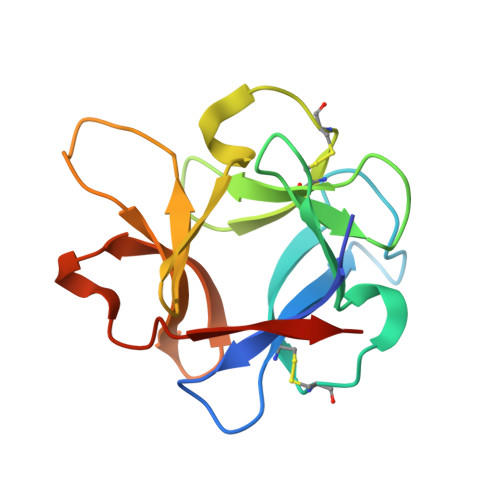Glycan Specificity of the Vibrio vulnificus Hemolysin Lectin Outlines Evolutionary History of Membrane Targeting by a Toxin Family.
Kaus, K., Lary, J.W., Cole, J.L., Olson, R.(2014) J Mol Biology 426: 2800-2812
- PubMed: 24862282
- DOI: https://doi.org/10.1016/j.jmb.2014.05.021
- Primary Citation of Related Structures:
4OWJ, 4OWK, 4OWL - PubMed Abstract:
Pore-forming toxins (PFTs) are a class of pathogen-secreted molecules that oligomerize to form transmembrane channels in cellular membranes. Determining the mechanism for how PFTs bind membranes is important in understanding their role in disease and for developing possible ways to block their action. Vibrio vulnificus, an aquatic pathogen responsible for severe food poisoning and septicemia in humans, secretes a PFT called V. vulnificus hemolysin (VVH), which contains a single C-terminal targeting domain predicted to resemble a β-trefoil lectin fold. In order to understand the selectivity of the lectin for glycan motifs, we expressed the isolated VVH β-trefoil domain and used glycan-chip screening to identify that VVH displays a preference for terminal galactosyl groups including N-acetyl-d-galactosamine and N-acetyl-d-lactosamine. The X-ray crystal structure of the VVH lectin domain solved to 2.0Å resolution reveals a heptameric ring arrangement similar to the oligomeric form of the related, but inactive, lectin from Vibrio cholerae cytolysin. Structures bound to glycerol, N-acetyl-d-galactosamine, and N-acetyl-d-lactosamine outline a common and versatile mode of recognition allowing VVH to target a wide variety of cell-surface ligands. Sequence analysis in light of our structural and functional data suggests that VVH may represent an earlier step in the evolution of Vibrio PFTs.
- Department of Molecular Biology and Biochemistry, Wesleyan University, 52 Lawn Avenue, Middletown, CT 06459, USA.
Organizational Affiliation:

















